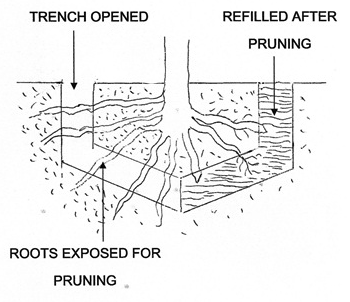Understanding root pruning
Root pruning is a crucial method employed to ensure the vitality of trees and safeguard the surrounding environment. Understanding Root Pruning is key to ensuring the safety of your landscapes, specifically when damage is occurring. By selectively trimming specific tree roots, this practice encourages proper root growth and prevents potential damage to structures and landscapes. In this article, we’ll delve into the fundamentals of root pruning and its advantages for your trees and outdoor areas.
Understanding root pruning
Root pruning entails carefully trimming or cutting certain tree roots to manage their growth and mitigate potential issues. This technique is frequently used to guide roots away from structures, walkways, driveways, and utility lines. By skillfully pruning roots, arborists can prompt them to grow deeper into the soil, cultivating a stable and healthy root system.
When is root pruning needed?
Root pruning is commonly conducted during tree transplantation or when planting new trees near existing structures. It’s also employed as a maintenance approach to regulate tree root growth and avert potential conflicts with hardscapes. Root pruning may be necessary in the following scenarios:
Tree Transplantation: During the relocation of a tree, root pruning reduces stress on the tree and encourages fresh root growth in the new planting site.
Damage Prevention: If tree roots are encroaching on buildings, pavements, or utility lines, root pruning redirects their growth, mitigating potential harm.
Landscape Planning: In landscaping projects, root pruning creates space for new plants, gardens, or structures while safeguarding existing trees.
Advantages of root pruning
Healthy Root System: Root pruning stimulates the development of a compact and robust root system. By trimming unnecessary or circling roots, the tree focuses on cultivating healthier roots that provide enhanced anchorage, water, and nutrient access.
Preserving Infrastructure: Steering tree roots away from buildings and hardscapes prevents costly structural and pavement damage. Sidewalks, driveways, and underground utilities remain intact.
Reduced Tree Stress: During transplantation or construction activities, root pruning alleviates stress on the tree, increasing its chances of survival and successful establishment.
Guidelines for root pruning
For effective and safe root pruning, it’s best to rely on trained professionals such as certified arborists. Here are some guidelines to follow:
Timing: Root pruning is most effective during the dormant season, typically late fall or early winter, when trees aren’t actively growing.
Appropriate Tools: Utilize sharp and clean pruning tools for precise cuts that minimize root damage.
Distance from Trunk: Avoid cutting roots too close to the tree’s trunk, as this could compromise its stability.
Watering: After root pruning, maintain proper watering to aid the tree’s recovery and stimulate new root growth.
Root pruning is an invaluable tree care method that fosters healthy root systems and guards against structural and hardscape damage. When executed correctly, root pruning enables your trees to flourish and enhances the allure and safety of your outdoor spaces. If you’re contemplating root pruning for your trees, seek advice from a certified arborist or tree care specialist for professional insights and assistance.





